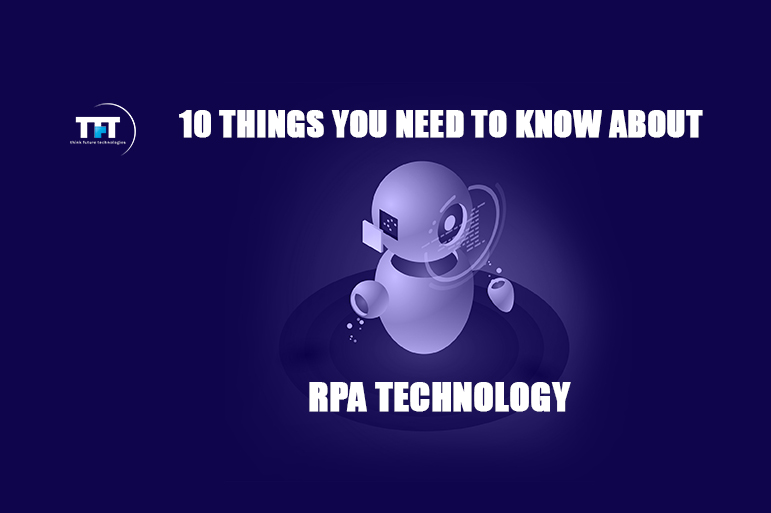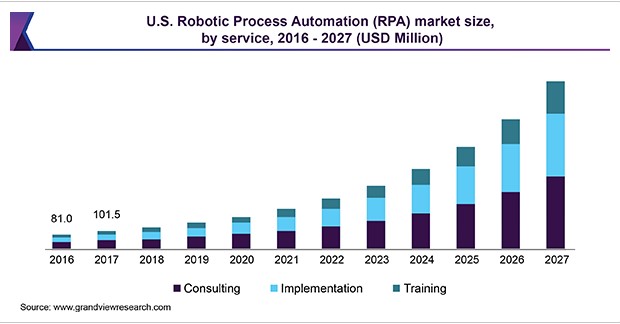
10 Things You Need To Know About RPA Technology
Robotic Process Automation (RPA) has evolved as a ground-breaking technology for business process improvement in recent times. It enables organizations to automate labour-intensive, repetitive, and high-volume tasks, and thus free up employees to focus on activities that drive business value. Implementation of RPA solutions brings in a bunch of benefits such as reduced expenditure, lower operational risks, enhanced customer experience, increased ROI, and much more.
Given the ever-increasing demand for business process automation using software robots, the global RPA market is growing at a rapid pace. The global RPA market size was valued at USD 1.1 billion in 2019. It is expected to grow at a CAGR of 33.6 % from 2020 to 2027.

With more organizations adapting to RPA solutions for IT, HR, finance function, and more, the business world is gearing up for another revolution. In this blog, we list ten must-know things about this rapidly evolving technology.
RPA is a software tool to automate manual activity
Simply put, RPA is a digital robot. Going with its definition, RPA refers to a software solution that is programmed to perform specific tasks similar to how humans do it. It can adapt to a particular workflow and do several types of tasks in a specific order. It works similar to a digital assistant for employees to ease up their job responsibilities.
RPA is best-suited for mundane, repetitive tasks
RPA software is primarily built to reduce the burden of redundant business functions that are inevitable but time-consuming. It works best with rule-based, repetitive tasks such as data entry, copy-pasting data from one application to another, data comparison, bookkeeping, invoice processing, etc. In a nutshell, RPA can be deployed to automate any business processes that require minimal human judgement.
With RPA solutions put in action, employees can utilize their workday on high-return, value-intrinsic tasks. Thus, it is a boon for forward-looking organizations that have an eye on increasing team efficiency and productivity.
RPA is easy to implement, customizable, and scalable
Among various technological tools for streamlining business operations, RPA is easy to implement and quick to benefit. Regardless of the current IT landscape, it is mostly customizable and can seamlessly work across multiple applications.
Scalability is yet another benefit of RPA technology. Depending on the organization’s requirement, task robots can be scaled up or down in RPA. For instance, during times of heightened business activity, more task robots can be deployed with minimal effort and be ensured of absolute consistency in job performance.
RPA is capable of reducing human errors in back-office processes
When complicated and mundane tasks are done with huge manual involvement, error-free operations remain a far-fetched dream for organizations. The average cost of human error is $62.4 million per year, in a company of 100,000 employees, as per a 2008 White Paper from IDC.
For organizations in which RPA solutions provide end-to-end automation services, the chance of human error is reduced drastically. Unlike humans, task robots can work round-the-clock, without lethargy and in full efficiency. Since robots make fewer mistakes than humans, the operational risks remain low.
RPA is not a replacement for your existing IT solutions
RPA solutions can be deployed without implementing any new IT infrastructure or expensive hardware, which is a significant factor that makes RPA different from other software solutions. It does not replace the existing processes or IT solutions but streamlines the functions.
The RPA workforce can adapt to the same systems that the human workforce use. Regardless of the current ERP solutions used in the organization, RPA solutions can be seamlessly integrated with the current processes and can be altered or updated anytime.
RPA ensures better data security
The digital workforce cannot hack data, retire from work, change job roles, or allow unauthorized access to crucial data. Also, it can inherit the current security infrastructure and follow the existing authorization concepts. It can generate backup copies of core processes and allows easy recovery of data after unexpected shutdowns.
RPA is not artificial intelligence
RPA is a digital robot that mimics human actions. It is a rule-based solution for process automation and has no intelligence of its own.
Artificial Intelligence (AI) is defined as the simulation of human intelligence by machines. It is programmed to think like humans, learn, reason, and self-correct, based on previous data. While RPA uses structured inputs and logic, AI solutions can develop their own logic and are capable of processing unstructured inputs.
RPA is for all organizations regardless of their size
Despite the company size and business domain, the back-end activities remain almost the same for businesses. Hence RPA-as-a-service solutions are advisable for any organization that looks forward to automating menial tasks and improving back-end processes. Given the current growth rate, RPA technology is expected to achieve near-universal adoption by 2023.
By putting RPA into action, large organizations can cut down operational costs considerably. Small businesses can avoid inefficient workplace practices and focus on enhancing business value without hefty investments.
RPA is not a robot that makes your workforce obsolete
RPA is not a physical robot that would make the existing workforce obsolete. With RPA implementation, employees can avoid dull data entry tasks and the like. It helps to reduce workload, alleviates negative stress, and leads to improved work-life balance.
Similar to other technologies, RPA is expected to create new job roles and redefine the current work responsibilities of the human workforce. It opens the door to more effective and value-driven human labour.
RPA is the stepping stone to Intelligent Automation
With AI and machine learning making deeper inroads across business functions, the age of Intelligent Automation is fast approaching. It is a combination of AI and RPA elements for enhanced business efficiency. RPA implementation is considered as a milestone for businesses that aim to become an intelligent digital enterprise in future.
RPA is rapidly emerging as a terrific technological tool that allows organizations to lead a future-ready business. When deployed correctly, it helps enterprises to improve operational efficiency cost-effectively and increase enterprise ROI significantly.
The power and potential of RPA technology can be escalated further when it is combined with AI and machine learning. In the current hyper-competitive business environment, organizations that fail to embrace the power of technology promptly are unlikely to succeed!
Recent Blogs
- Hire Best Remote Software Developers: Why AI Can’t Replace Human Expertise
- Low-Code RPA: Empowering Citizen Developers Through Automation
- RPA Software Solution: Intelligent Document Processing with RPA
- RPA Software Solution: Transforming Business with Smarter Automation Tools
- Salesforce Implementation Services: Meet Your New AI Teammates
Categories
- Agritech (1)
- AR/VR (5)
- Artificial Intelligence (55)
- Machine Learning (1)
- Blockchain (4)
- Business Intelligence (3)
- CRM (5)
- SalesForce (4)
- Data Engineering (8)
- Data protection (2)
- Development (102)
- Golang Development (15)
- Python Web Development (9)
- React JS (5)
- React native (10)
- Devops (3)
- Hire Developers (3)
- Internet of Things (IoT) (5)
- Kubernetes (2)
- Machine Learning (2)
- Mobile App Development (44)
- Node.js (7)
- outsourcing (7)
- Partnership (4)
- Performance Testing (3)
- RPA (24)
- Security (24)
- Strategy (1)
- Testing (110)
- Accessibility Testing (2)
- Automation Testing (22)
- Dynamic Testing (1)
- Manual Testing (3)
- Mobile App Testing (13)
- Offshore Software Testing (6)
- Penetration Testing Services (13)
- QA testing (16)
- Remote Software Testing (7)
- Software Testing (19)
- Website Design (22)